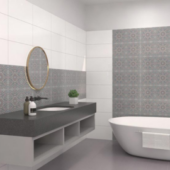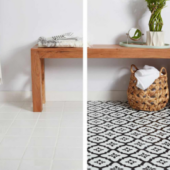When it comes to designing small spaces, every detail matters. The right tile selection can significantly enhance the perception of space, making small rooms appear larger and more inviting. This ultimate guide on tile selection for maximizing small spaceswill provide you with essential tips and insights on choosing the best tiles to transform your home.
Understanding the Impact of Tile Selection
The type, size, color, and layout of tiles can greatly influence the visual space of a room. Proper tile selection for maximizing small spaces involves understanding how these factors work together to create an illusion of more space. Here are key aspects to consider:
- Tile Size Matters
Choosing the right tile size is crucial in small spaces. Contrary to popular belief, larger tiles can make a small room appear more expansive.
Benefits of Larger Tiles:
– Fewer grout lines create a seamless look, reducing visual clutter.
– Larger tiles give the impression of a continuous surface, which can make the room feel bigger.
– Ideal for floors and walls in small bathrooms, kitchens, and living areas.
When to Use Smaller Tiles:
– In areas where intricate patterns are desired, such as backsplashes or decorative accents.
– For creating a focal point without overwhelming the space.
- Light and Neutral Colors
Color plays a significant role in enhancing small spaces. Light and neutral-colored tiles can make a room feel open and airy.
Best Color Choices:
– Whites, creams, light grays, and pastels reflect more light, creating a bright and spacious feel.
– Neutral tones can complement various design styles and color schemes.
How to Use Color:
– Use light-colored tiles for walls and floors to maximize the reflection of natural and artificial light.
– Consider glossy finishes for tiles, as they reflect light better than matte finishes.
- Patterns and Layout
The pattern and layout of tiles can also impact the perception of space.
Patterns to Consider:
– Diagonal Layout: Installing tiles diagonally can trick the eye into seeing the room as larger.
– Herringbone and Chevron Patterns: These patterns can elongate the space and add visual interest without overwhelming it.
Layout Tips:
– Avoid busy and complex patterns in very small rooms, as they can create visual clutter.
– Consistent and simple layouts with minimal interruptions enhance the flow of the space.
- Consistency and Continuity
Creating a sense of continuity in your tile design helps to maximize space.
Strategies for Continuity:
– Use the same tiles for both the floor and walls to create a seamless look.
– Extend floor tiles into adjoining rooms to create a unified and expansive appearance.
- Reflective and Glossy Surfaces
Tiles with reflective or glossy surfaces can enhance the sense of space by bouncing light around the room.
Benefits:
– Reflective surfaces brighten the room and create the illusion of depth.
– Glossy tiles are particularly effective in small bathrooms and kitchens.
- Textured Tiles
While smooth, glossy tiles are great for reflecting light, incorporating textured tiles strategically can add depth and interest without compromising space.
How to Use Textured Tiles:
– Use textured tiles as accents or feature walls to create a focal point.
– Pair textured tiles with smooth tiles to balance the design and avoid visual clutter.
Tile Selection Tips for Specific Areas
Different areas in a small home require different tile selection strategies. Here are tips for some common areas:
Small Bathrooms
– Floor Tiles: Use large, light-colored tiles to make the floor space appear bigger.
– Wall Tiles: Extend the wall tiles to the ceiling to draw the eye upward and create a sense of height.
– Accent Tiles: Use a single accent wall or stripe to add character without overwhelming the space.
Small Kitchens
– Backsplash: Use light-colored, glossy tiles for the backsplash to reflect light and make the kitchen feel open.
– Flooring: Opt for larger tiles in a consistent color to maintain a seamless flow from the kitchen to adjoining rooms.
– Cabinet and Tile Coordination: Match the color of the tiles with the cabinetry to create a cohesive look.
Small Living Areas
– Consistency: Use the same tile throughout the living area to create a unified, spacious look.
– Accent Walls: Create an accent wall with a different tile pattern or color to add interest and depth.
Small Bedrooms
– Flooring: Use large, neutral-colored tiles to make the bedroom feel more expansive.
– Accent Tiles: Consider a small accent area, such as behind the bed, to add texture and character without shrinking the space.
Conclusion
Effective tile selection for maximizing small spaces involves considering the size, color, pattern, and finish of the tiles. By choosing larger, light-colored tiles with reflective surfaces and strategic patterns, you can create the illusion of more space and enhance the overall aesthetic of your home.
For expert advice and a wide selection of tiles, visit Chandan Marbles located on Nagar Rd, opposite Forest Park near Yadav Petrol Pump in TulajaBhawani Nagar, Lohegaon, Pune. Feel free to call us at +91 8888843560 or visit our website at www.chandanmarbles.com.






